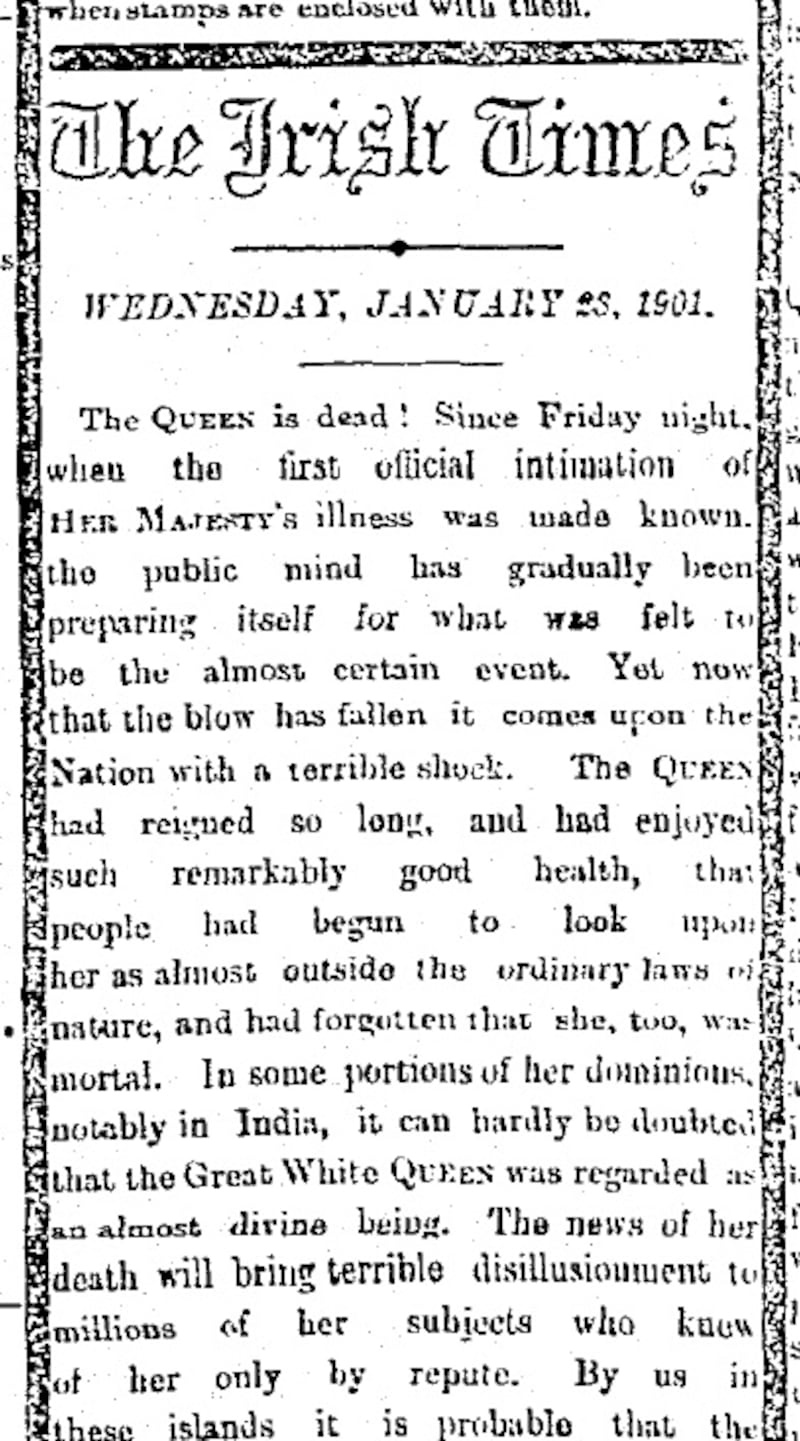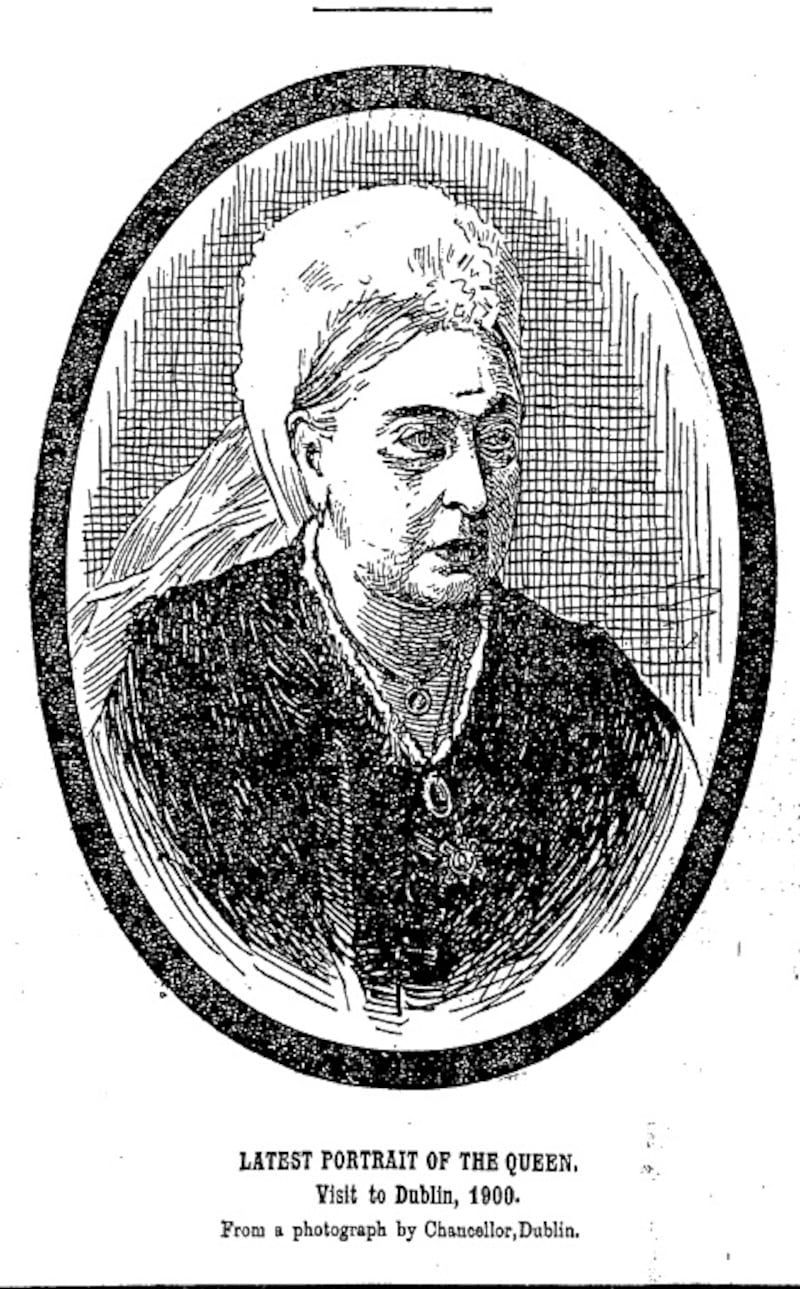“The Queen is dead!”
The Irish Times, in the opening declaration of its leader on January 23rd, 1901, echoed the alarm it reported among Irish people at the death of Queen Victoria the previous day.
The same shock, reports on its news pages would say, was felt along with “profound dismay amongst the loyal citizens of Dublin”.
The death of Queen Victoria in 1901 played out much like a live news story. It had been anticipated. The queen had been in ill health, but things had taken a turn the previous Friday night, and early on the Saturday morning of January 19th, it was announced that she was suffering from “extreme prostration, accompanied by the symptoms that caused anxiety”, and the news had trickled out by the afternoon.

On the 21st, The Irish Times wrote in a leader that her condition had “been watched literally from hour to hour, with the profoundest anxiety throughout the British Empire” since the news came through.
In the final hours of her life, updates were posted outside the offices of The Irish Times and newspapers’ offices as bulletins carrying physicians’ signatures came through from the queen’s death bed at Osborne House on the Isle of Wight, feeding what the newspaper depicted as thousands of people waiting in suspense and worry.
The march towards the end, in its fragmented and incremental delivery from the queen’s physicians, provided decent material for a one-day timeline at the very start of the report that finally marked her death. Intertwined were late telegrams received by the Lord Mayor of London in parallel with the official updates. Edited for clarity and chronology, it read something like this:
January 22nd, 1901
- Bulletin, no timestamp: "The Queen this morning shows signs of diminishing strength, and Her Majesty's condition again assumes a more serious aspect."
- Bulletin, 12pm: "There is no change for the worse in the Queen's condition since this morning's bulletin. Her Majesty has recognised the several members of the Royal Family who are there. The Queen is now asleep."
- Bulletin, 4pm: "The Queen is slowly sinking."
- Telegram from the Prince of Wales to the Lord Mayor of London, 4pm: "My painful duty obliges me to inform you that the life of the beloved Queen is in the greatest danger."
- Message from the King to the Lord Mayor of London, 6.30pm: "My beloved mother has just passed away, surrounded by her children and grandchildren. - Albert Edward. "
- Bulletin, 6.45pm: "Her Majesty the Queen has breathed her last at 6.30pm, surrounded by her children and grandchildren."
It’s a close level of detail, and not unusual in its breadth and adulation when it came to Irish Times reports about a monarch in those years. It’s the very same tone you’d find in reports about official visits and Royal weddings.
Victoria’s death marked a particularly grief-laden outpouring in the editorial comment. Her longevity - 63 years is a long time to reign - was pointed to by The Irish Times as a reason why her death might deal such a serious blow to her subjects, many of whom had not known life without her.

“The news of her death will bring terrible disillusionment to millions of her subjects who knew of her only by repute. By us in these islands it is probably that the full effect of HER MAJESTY’S death will not be realised for some months, perhaps even for some years. For the present what we all feel is the personal loss, the enormous blank that has been made in our own individual lives. The QUEEN was so much a part of the established order of things that it is difficult to realise that anything can go on without her. Men have been born, have had children born to them, and seen their children’s children, without ever knowing another Monarch besides VICTORIA.”
As the news rippled around Dublin some time after 7pm, businesses that would otherwise have stayed open began to pull their shutters down and church bells began to toll. Pantomime season was reportedly at its zenith, yet the prominent theatres of the day - the Theatre Royal, Gaiety, Queen's and Empire Palace (now the Olympia) - refunded customers who had arrived early and closed up. There would be no performances that night.
“Until a late hour of the night, the streets were thronged with very large crowds, and on all hands the deplorable event was the sole topic of conversation,” reads a news report in The Irish Times.
Expressions of grief lasted all the way to the weekend edition, which - replete with a front page illustration of Victoria - declared the previous Wednesday (the day following Victoria’s death), “one of the most depressing days experienced in Dublin for years”.
The writer describes a bleak scene on Grafton Street, where both the window dressers of the drapery establishments and pedestrians had swapped their usual peppering of colours for blacks; “bright colours were conspicuous by their absence”.
‘Touching message’
The reported sorrow wasn't confined to Dublin. Dispatches from around the country reported similar grief in Cork, Limerick, Belfast and Derry. International reaction was well-covered, with a "touching message" of condolence coming from the 25th president of the United States, William McKinley, who would himself be dead by the year's end, albeit at the hands of an assassin.

In those first couple of editions after the queen’s death, one episode seemed to particularly irk The Irish Times, judging by editorial comment on the 24th. The unfortunate event, by the paper’s estimation at least, happened at the previous day’s quarterly meeting of the Dublin Corporation.
The main business of the day was to elect a new Lord Mayor, but before that went ahead, it was proposed by the sitting Lord Mayor that business be preceded by a vote of condolence with the Royal Family. Not everyone agreed the format change was appropriate.
Points of order were raised and the business of the day went ahead, instead. At the meeting’s end, the topic came around again. Nationalist members objected to the concept; it was not the duty of the corporation to “express either condolence on a sad, or gratification on a joyful occasion as far as Ireland was concerned”. The resolution would be carried, minus a proposed amendment, but the “squalid debate”, as The Irish Times put it, had already taken place.
Among columns of tribute and solemnity, it was clear that the newspaper found the Dublin Corporation condolence saga shameful. Politics, it suggested, had no part to play in the death chamber: “The awful sanctity of death, the innate chivalry of the Irish nature, the Queenly virtues of the dead Sovereign, the sacred and imperishable and indestructible reverence of the Celt in the presence of the open grave, availed nought with the Municipal Council of the metropolis of Ireland.”
READ THE ORIGINAL REPORTS
[ The Irish Times, January 23rd, 1901Opens in new window ]
[ The Irish Times, January 24th, 1901Opens in new window ]
[ The Weekly Irish Times, January 26th, 1901Opens in new window ]


















